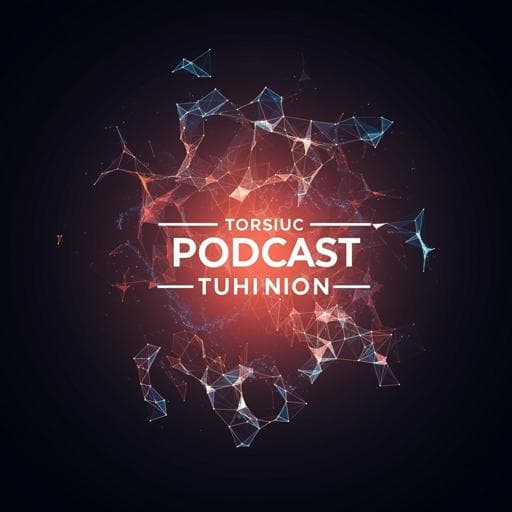
Education
An artificial intelligence approach for selecting effective teacher communication strategies in autism education
V. Lampos, J. Mintz, et al.
This groundbreaking research by Vasileios Lampos, Joseph Mintz, and Xiao Qu explores how artificial intelligence can enhance communication strategies for children with autism spectrum conditions. By analyzing classroom interactions, the study highlights the varying effectiveness of different approaches, showcasing AI's transformative potential in autism education.
~3 min • Beginner • English
Introduction
The prevalence of autism spectrum conditions (ASC) in children has risen substantially, creating pressing needs for effective educational practices tailored to autistic learners. Communication difficulties are central in ASC and strongly influence educational, social, and long-term life outcomes. While AI has been increasingly applied in education, prior work has largely focused on learning analytics or on autism diagnosis and screening rather than on in-class interactions. This study investigates whether machine learning can model real-time teacher-student interactions in primary classrooms to help select communication strategies (e.g., verbal, gesture, physical prompt, visual supports) that maximize the likelihood of a desired student response. The authors devised a protocol to observe and code teacher communications, contextual factors, and student responses, then trained classifiers to predict the probability of a full student response under specific classroom conditions and student attributes. The goal is to provide evidence that AI can support tailored pedagogical decision-making for students with ASC and to examine short- and longer-term effects of different communication strategies.
Literature Review
Most machine learning research related to autism has addressed screening and diagnosis, aiming at earlier and more accurate identification. In contrast, little to no prior work has modeled in vivo classroom interactions between teachers and students with ASC. Autism education literature emphasizes the importance of communication strategies for learning and social communication development, with frameworks such as SCERTS commonly guiding practice. There is strong emphasis on visual supports (e.g., Picture Exchange Communication System, schedules), which have shown benefits in communication and independence. Verbal-only approaches are often less effective for autistic learners, and concerns exist about over-reliance on physical prompting due to potential impacts on independence. This study fills a gap by comparing multiple communication strategies in naturalistic classroom settings using machine learning.
Methodology
Setting and participants: Structured observations were conducted across 20 full-day sessions over 5 months in 2019 at a special school for children with ASC in East London. Participants were three teachers (one male, two females), teaching assistants (all females), and seven students (four males, three females), ages 6–12 years, across three classes. Student P-scales ranged approximately from P3 to P6.
Data: A total of 5460 adult-student interactions were coded, spanning classroom and other school settings (e.g., playground, library, therapy rooms). Of these, 500 observations were distinct when considering all variables; 4880 distinct when considering student response; 4357 distinct when also considering teacher communication strategy. Teachers most frequently used verbal communication (about 57% of instances), either alone or in combination with another strategy.
Observation schema (feature categories and subtypes):
- Student attributes: sex, age (normalized 5–12 years to 0–1), P-level, SCERTS classification.
- Teaching objective: academic, social, or pedagogic (social interaction toward an academic goal).
- Teaching type: giving instructions, modelling, redirection, questioning, encouragement/praise, initiating conversation.
- Context for teaching type: whole class, small group, individual attention, individual work withdrawal, transition.
- Student’s observed emotional state: positive, negative, neutral.
- Teacher’s communication strategy: verbal, gesture, physical prompt, picture, object. Communications could occur singly or in pairs (dual communications).
- Outcome (target): student response categorized as full, partial, or no response; for classification, outcomes were binarized as full response vs otherwise to balance classes (about 56.95% full).
Machine learning task: Predict whether a student will give a full response given the current interaction context and selected teacher communication(s).
Models and features: Tested classifiers included (a) logistic regression with elastic net regularization, (b) random forest with 200 trees, and (c) Gaussian Process (GP) models with additive composite kernels. Feature sets were built incrementally: (i) context-inclusive features excluding student attributes; (ii) with student attributes added; (iii) autoregressive variants including up to the previous 5 interaction observations and student responses as regressors. GP models used additive exponential kernels over feature groups, enabling inclusion of current observation features, student attributes, and past observations/responses.
Evaluation: Performance was estimated using repeated 10-fold cross-validation (folds matched across comparisons). Ablation analyses evaluated single feature groups and leave-one-group-out configurations to assess each feature category’s contribution. Additional analysis sampled an expanded synthetic interaction space (>2.6 million unique instances) to examine broader patterns using the best GP model trained on all collected data.
Operational details: The GP classifier provided real-valued scores mapped to non-calibrated probabilities over outcomes; strategy recommendations were generated by activating candidate communication(s) in the model and ranking the resulting probabilities of full response to select the highest. MATLAB R2019a toolboxes and GPML were used for implementation.
Key Findings
Predictive performance (full-response prediction; mean ± SD):
- Baseline models: Logistic Regression (LR) Accuracy 0.677 (0.017), Precision 0.798 (0.019), Recall 0.684 (0.031), F1 0.736 (0.015); Random Forest (RF) 0.686 (0.014), 0.803 (0.023), 0.692 (0.028), 0.743 (0.014); Gaussian Process (GP) 0.697 (0.015), 0.794 (0.019), 0.708 (0.029), 0.748 (0.013).
- With expanded features (including student attributes and/or context/past): LR-A 0.688 (0.024), 0.790 (0.018), 0.698 (0.032), 0.741 (0.021); RF-C 0.701 (0.012), 0.784 (0.028), 0.716 (0.028), 0.748 (0.013); GP-A 0.711 (0.015), 0.800 (0.019), 0.720 (0.024), 0.757 (0.014). Best performance was achieved by GP with all features including student attributes and past observations.
Feature importance (ablation; accuracy ± SD):
- Using only one feature category: past observations 0.631 (0.015); teaching type 0.597 (0.015); student emotional state 0.598 (0.023); teacher communication strategy 0.588 (0.015); context 0.572 (0.018); teaching objective 0.566 (0.023).
- Leave-one-out: excluding teacher communication strategy reduced accuracy to 0.684 (0.022), the largest drop, indicating this category contributed most strongly; excluding teaching type 0.696 (0.019); excluding objective 0.705 (0.018). All features together: 0.707 (0.015).
Descriptive and temporal patterns:
- Overall full response rate in the data was about 56–57% (e.g., 56.59% convergence in cumulative analyses; 56.95% after binarization).
- Two teacher communications tended to outperform single communications in eliciting full responses.
- Temporal analyses of sequences suggested that visual prompts (picture or object) increased full response in the short term and peaked approximately two steps after application; physical prompts showed immediate gains followed by a notable subsequent drop and a lower long-term return to the mean compared with other strategies.
Expanded scenario sampling (n > 2.6 million simulated interactions scored by best GP model):
- Highest absolute correlations with full response: negative emotional state r = -0.431 (p < 0.001), physical prompt r = 0.341 (p < 0.001), verbal communication r = -0.292 (p < 0.001), encouragement/praise teaching type r = 0.225 (p < 0.001).
Additional statistical observations from the collected set:
- Teachers most frequently used verbal communication (~57% of instances). Full-response rates by strategy (irrespective of co-occurrence): picture ~0.642; object ~0.692; physical prompt ~0.661; gesture ~0.580; verbal ~0.523. These patterns indicate visual prompts and physical prompts were generally more effective than verbal-only, with gestures intermediate.
Discussion
The study demonstrates that a machine learning classifier trained on real-time classroom observations can meaningfully predict which teacher communication strategies are more likely to elicit a full response from students with ASC under specific conditions. Accuracy improved when student attributes and past interactions were incorporated, indicating that personalization and temporal context are important. Ablation analyses highlighted that the teacher’s communication strategy is the most influential feature group, reinforcing the practical importance of selecting appropriate strategies.
Findings align with and extend existing literature: verbal-only communications are comparatively less effective for autistic learners, whereas visual supports often enhance responsiveness. Temporal analyses suggest strategic use of visual prompts can lead to short-term gains that peak shortly after use, while physical prompts, despite immediate effects, may reduce engagement later in a sequence, underscoring the need for careful deployment to support independence. Moreover, combining two communication modes typically outperforms single-mode prompting, suggesting additive or complementary effects.
Practically, the model can be used prospectively: for a given student profile and classroom context, it can rank candidate communication strategies (including dual strategies) by predicted probability of success, supporting teacher decision-making to enhance inclusion and engagement. Although probabilities are not calibrated, relative rankings enable actionable recommendations. These results suggest AI-driven tools could help tailor pedagogical strategies to individual students in vivo, potentially improving classroom participation and learning outcomes.
Conclusion
This work introduces an AI-based approach that learns from naturalistic classroom observations to recommend teacher communication strategies for students with ASC. Using 5460 coded interactions, the best-performing Gaussian Process model achieved approximately 0.71 accuracy, with communication strategy emerging as the most impactful predictor. Analyses indicate that combining communication modes is often advantageous, visual prompts can yield strong short-term benefits, and verbal-only approaches are comparatively less effective.
Future research should: (1) validate the model with larger, more diverse cohorts to improve generalizability; (2) incorporate additional standardized and ecologically valid student attributes (e.g., sensory profiles, attention, language measures); (3) leverage multimodal data (e.g., video-based measures of proximity, gaze, and affect) to capture richer context; (4) calibrate predicted probabilities and evaluate real-time decision-support in classrooms; and (5) conduct prospective or randomized studies to assess causal impacts of strategy recommendations on engagement, learning, and independence.
Limitations
The study is exploratory with several limitations: (1) small sample (seven students, three teachers) from a single special school limits generalizability; (2) student attributes were educational indicators rather than standardized clinical measures; (3) potential sampling and observational biases, with limited coverage of the large space of possible interaction scenarios; (4) sensitive data constraints prevent open sharing and replication; (5) strategy probabilities are not calibrated, and recommendations rely on relative ranking; (6) the coding scheme may omit influential variables (e.g., teacher-student proximity, sensory environment, individual preferences), and expanding features would require substantially more observations; (7) limited sequence length analyzed may not capture longer-term effects of prompting on independence.
Related Publications
Explore these studies to deepen your understanding of the subject.







